Delta : Observing teaching
 |
If you are observing in your capacity as an Academic Manager, this is not the place for you. There's a separate guide in the Academic management section of this site.
During the course for Delta Module Two, you will need to observe 10 hours of other teachers at work. This can be of live or recorded lessons or a combination of both. There are good reasons for this requirement as you might imagine.
- The Cambridge English Delta Handbook, referring to the
Professional Development Assignment, states:
Where possible, the peer observations required for Module Two should be used to gather data for the action plan. Candidates may use data from their own observations of colleagues as well as their colleagues' observations of them.
(Cambridge English Delta Handbook for Tutors and Candidates, p 57) - Observing other teachers is an immensely useful source of professional development because you not only get to hear about a technique or approach but can actually see it in action.
- Observing other teachers can often alert you to things they do better than you or reassure you that you do things well.
 |
The fly on the wall |
The main objective of what follows is to encourage you to be
more than a fly-on-the-wall observer but to be active
with an agenda to follow and a reason for being in a
colleague's classroom (or watching a recorded lesson).
Observation for developmental purposes should not be a passive process
and both observer and observed should get something positive from the
experience.
 |
Know what you are looking for |
When you come to write the first Stage of Part A of the Professional Development assignment, you need to identify between 3 and 5 areas of your practice that you know need improvement. What these areas are is going to be different for everyone, of course, but here are some typical choices based on those identified by many Delta candidates in the past:
- Varying how feedback is given more appropriately
- Focusing more consistently on pronunciation
- Allowing students more time
- Improving instructional language
- Planning time better
- Keeping a better focus on the lesson's targets
- Cutting out unnecessary teacher talk
- Becoming less teacher- and more learner-focused
- Involving all the learners equitably
- Using your own voice more effectively
- Monitoring more effectively
- Dealing better with error
- Dealing better with emerging language
- Providing accurate and appropriate language and skills information
- Ensuring adequate practice
You may have other priorities but it's a safe bet that at least some of what you hope to achieve will be in the list above. These targets are susceptible to the use of observation as one of the ways you hope to hit them.
In the PDA Part A, Stage 1, you have set out an action plan showing
what you intend to achieve, how you will do it and
your ideas for evaluating the outcomes.
The what in the action plan will be based on your own
intuitions, the feedback you got from the diagnostic lesson, responses
from learners and feedback from other observers you may have had in your
lessons.
The observation of other teachers is part of the how of that
action plan and that means you need to ...
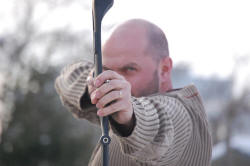 |
... have clear aims |
Once you know what you want to get out of observation, life becomes
easier and it becomes even easier if you take the time to write down
what it is that you are looking for.
For example:
Over this series of ten lessons, I want to see how my colleagues ...
- ... maintain the learners' focus
- ... correct
- ... make sure everyone is involved
- ... use their voice
- ... take feedback from tasks
- ... give feedback to the learners
- ... balance the time between controlled practice and freer production
- ... monitor
etc. It's your decision, of course, based on where you want to
get to, but a series of ten lessons should give you a good range of
possible targets.
Once you have decided what it is you want to learn, you need to design
observation tasks for yourself to help you focus.
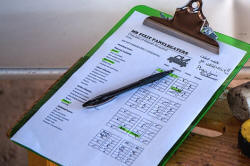 |
Observation tasks |
Good observation tasks help you to get away from being a fly on the
wall and focus on the relevant behaviours that are the targets of the
process. This section contains some ideas but, of course, the
tasks you set yourself must match the targets you have in mind.
There is little point, for example, in writing a long description of how
the teacher gave instructions if you are interested more in how she
dealt with language that emerged spontaneously from the learners.
 |
Charts |
There are lots of ways to use charts well when observing teaching.
Charts allow a quick way to record data, can be very informative and can
later be used to compare the different ways different teachers deal with things like
apportioning time, gaining and maintaining attention and groupings. For example:
If you want to measure the amount of teacher vs. learner talk and map it
against your estimation of energy levels in the classroom, you could use
something like this.
Start with a blank chart and three coloured
pens to play with while the lesson progresses. You can also use a set of blank circles and make pie charts if that's
easier. Clearly, you can vary the parameters to suit what you want
to be the focus.

Then, when you have recorded one of your own lessons, you can do the same thing and compare what you saw with what you did. That can be a very informative procedure.
A reasonably simple alternative type of chart is something like this which is intended to focus on error correction and instruction checking but could be used for all sorts of other purposes such as concept checking, nomination of learners and so on. You place a bar on the line where you believe it should go and then, later, compare this with what you do in a typical lesson.
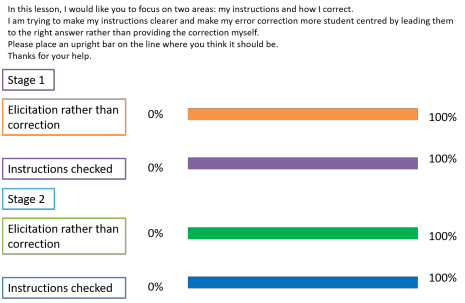
For time apportioning, an effective chart type is the pie chart which may look something like this:
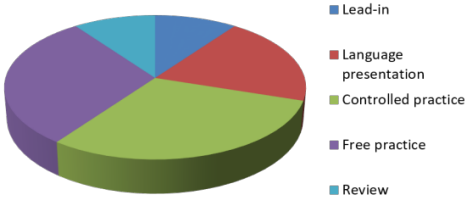
Again, a comparison with the typical result from a similar lesson that you have taught can be very informative especially if you find wide variations.
Interaction patterns are also candidates for graphical representation. For example:
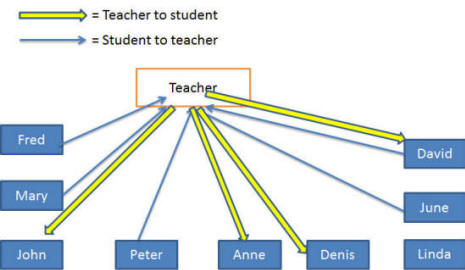
This sort of chart quickly shows how equitably attention is shared and who are the most forthcoming learners etc. It will soon become messy if you try it for the whole lesson so is best reserved for plenary sections of the lesson or for short snatches only.
 |
Focused note taking: using forms |
Don't start with a blank sheet of paper. Before you watch, make
yourself some kind of form to keep you focused.
Here are some examples:
Factors affecting learning:
| Positive | Negative | |
| The environment | ||
| The teacher's roles | ||
| The task types | ||
| Grouping | ||
| Feedback form |
Lesson shape:
In the columns
- note what the learners were doing (e.g., working in pairs to solve a problem, making lists individually, listening and taking notes etc.)
- note what the teacher was doing (e.g., presenting new data, monitoring, sitting out etc.)
- note what sort of activity this was (e.g., skill getting, awareness raising, skill using, testing, consolidating, free practice etc.)For more, see the guide to task and activity types.
| Time | Student activity | Teacher role | Activity type and aim |
| Minutes 0 - 10 | |||
| Minutes 11 - 20 | |||
| Minutes 21 - 30 | |||
| Minutes 31 - 40 | |||
| Minutes 41 - 50 | |||
| Minutes 51 - 60 |
Instructional language
| Activity | Framed? | Clear? | Concise? | Checked? | Demonstrated? | Repeated? |
Questioning
| Question type: | Question concerned ... | Learner response was ... | Aim was ... |
| Closed | |||
| Open | |||
| Display | |||
| Communicative | |||
| Procedural |
Open questions require a bit more detail and are often wh-questions asking why?, how?, what for? etc.
Display questions are normally used to check learning and require the learner(s) to display their knowledge and grasp of a concept. Concept-checking questions are included in this category.
Communicative questions are 'real' in the sense that there is no right answer. In real life, most questions are like this.
Procedural questions concern the mechanics of tasks and are often used to check that instructions have been understood.
For more, see the guide to asking good questions.
Exploiting learner output
| Learner output: | Concerned | Relevance | Teacher response ... | Effect ... |
| Planned | ||||
| Spontaneous |
Dealing with error
| Error type | Error was ... | Corrected? | Peer correction? | Self-correction? | Teacher correction? | Outcome? |
| Referential | ||||||
| Syntactical | ||||||
| Phonological | ||||||
| Stylistic | ||||||
| Interpretive |
 |
Focused note taking: using headings |
Notes do not have be so complicated and it is not always necessary to design a form. It is frequently enough simply to write down some headings, leaving large blank spaces for your notes. The headings, of course, need to reflect the targets of your observation. They might be, for example:
- Instructions: what can I learn about giving these?
- Dealing with error: how did the teacher do this and what can I learn?
- Giving feedback: what ways were used and which ones can I incorporate into my teaching?
- Pronunciation: when and how was this made the focus? What should I be doing?
- Teacher talk: how much was there, what was it for and what can I learn?
- Monitoring: when and how was it done and what were its purposes? What can I learn?
and so on.
 |
Mirroring observationsAs others see us ... |
The ideas outlined here for observing other people doing their jobs
can be reversed.
Instead of you using the forms, charts and other techniques, you can
provide these to a colleague and get him or her to observe your
behaviour.
It is then a simple but informative matter to compare the results of
your observations with the results of other people's observations of
you.
 |
Observer behaviour |
Please remember that you are a guest and there to learn, not judge, suggest or assess. This means:
- Being as unobtrusive as possible
- do not distract the learners
- if possible sit behind the learners, out of eye contact
- arrive when you say you will and don't overstay your welcome
- Being open and honest
- make any notes or diagrams available to the teacher if you are asked
- if you have a post-lesson chat, listen, don't question or criticise what you saw unless you are asked
- avoid identifying the teacher personally in anything you write
For more ideas about developmental work, go to the development section of this site.
| The Delta index |
